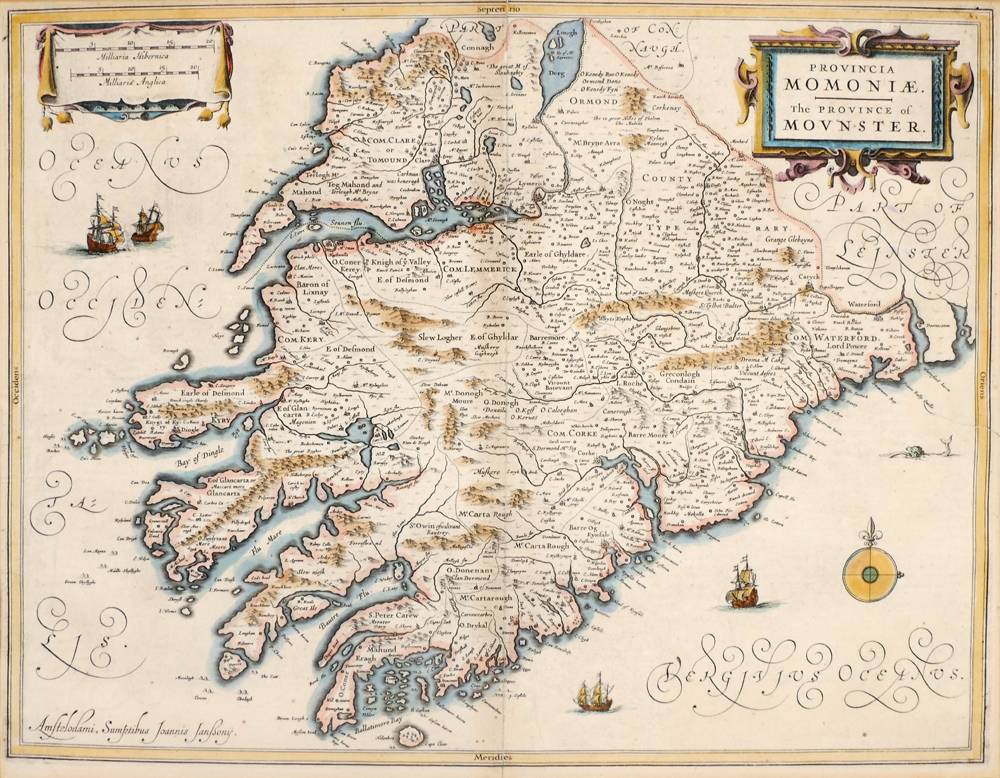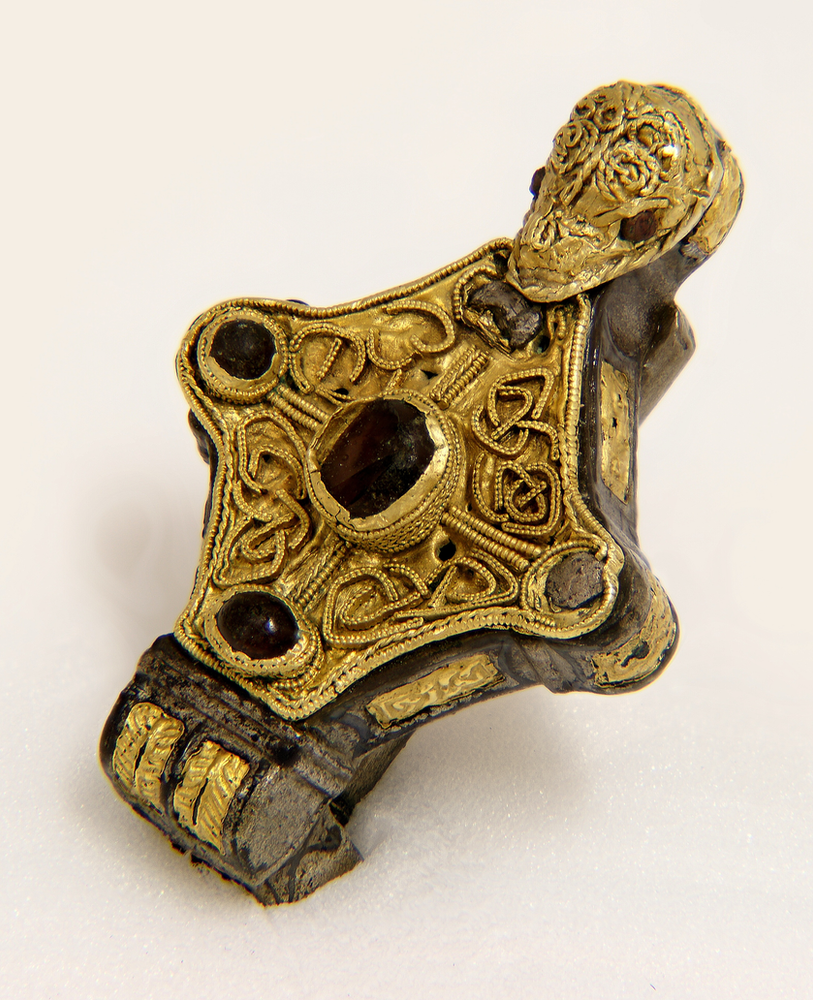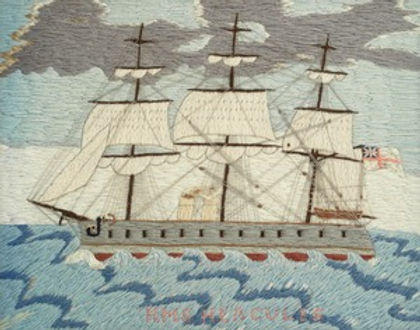
On the top floor of the Bishop’s Palace, there is a small framed picture of a ship. Look a little closer and you’ll notice that it isn’t a painting, but a piece of embroidery, made up of small, neat stitches. An old-fashioned tall ship sails on a blue ocean, while flags flutter around it. Created by a sailor, this unusual piece of wool art is better known as a sailor’s woolly, and like every object in the museum, it has a story behind it. This particular story begins with talented artists, determined to paint the sea…
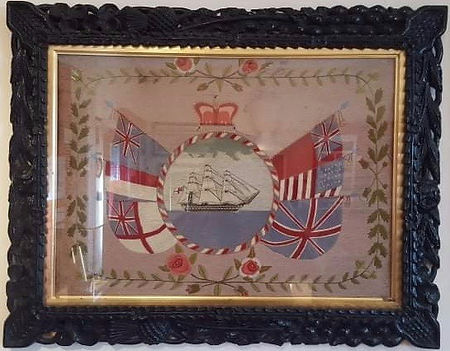
The sailor’s woolly in the Bishop’s Palace
“…our way, to my great delight, lay along the quays and beside the great multitude of ships of all sizes and rigs and nations. In one, sailors were singing at their work, in another there were men aloft, high over my head, hanging to threads that seemed no thicker than a spider’s. Though I had lived by the shore all my life, I seemed never to have been near the sea till then.”
As young Jim Hawkins, from Robert Louis Stevenson’s Treasure Island walks along the docks, he is spellbound by the smell of salt and tar, the sight of painted figureheads on the front of ships, and the sailors themselves, who have been to places Jim has only dreamt of. The power of the sea, and sailors’ ability to travel across it, has long captured the imagination of writers and artists. The eighteenth-century painter Claude Joseph Vernet (1714–1789) painted epic dramas, full of sudden bursts of light, and storm-lashed, roiling waves. Winslow Homer (1836–1910) often focused on humanity’s relationship with the sea, placing people firmly in the marine landscape. His 1885 painting, The Fog Warning, captures a fisherman rowing back to his ship, trying to decide if he can make it back before he’s engulfed in the fog, or if he must throw the day’s catch overboard in order to stand a chance of getting back in time. JMW Turner’s watercolours frequently catch the fabulous play of light thrown across the water by the setting sun. But what of the people who knew the moods of the sea far better than anyone else?
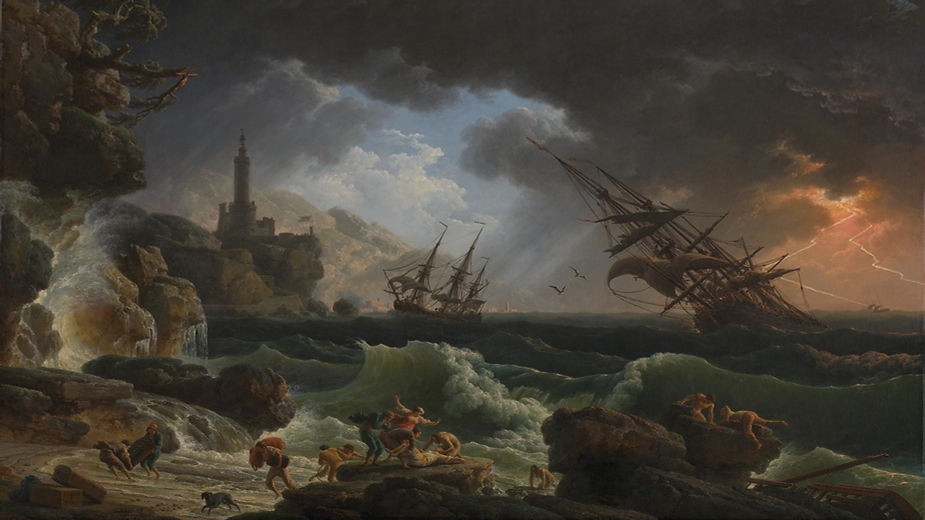
Ripe with melodrama: ‘A shipwreck in stormy seas’ by Claude Joseph Vernet at the National Gallery.
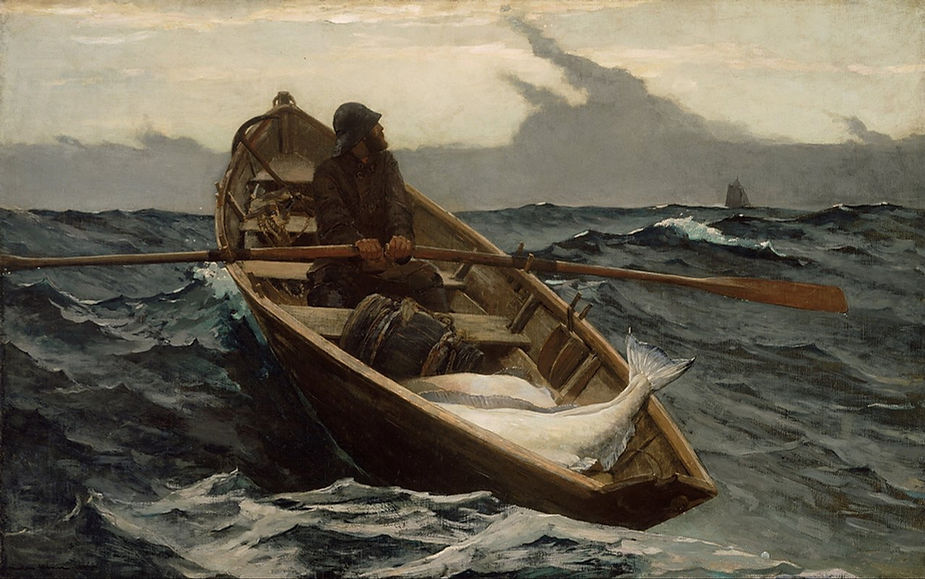
‘The Fog Warning’ by Winslow Homer, Boston Museum of Fine Arts.
Sailors were adept at capturing life at sea in art, albeit in very different ways to professional artists. Perhaps the most famous sailor-turned-artist is Alfred Wallis. Wallis (1855–1942), who reportedly joined the Merchant Navy at the age of 9, sailed between his native Cornwall and Newfoundland and only took up painting in his sixties, to stave off loneliness after the death of his wife. Wallis was too poor to afford canvas, and frequently painted his seascapes on scrap pieces of wood and cardboard. His lack of any artistic training meant that his work was simplistic in its use of colour and perspective, and is often described as childlike. However, in this simplicity, he captures the beauty and danger of a vanishing way of life. The avant garde painters Ben Nicholson and Christopher Wood saw in Wallis’ work what they were trying to do themselves – to paint the world, not exactly as it looks, but how it seems.
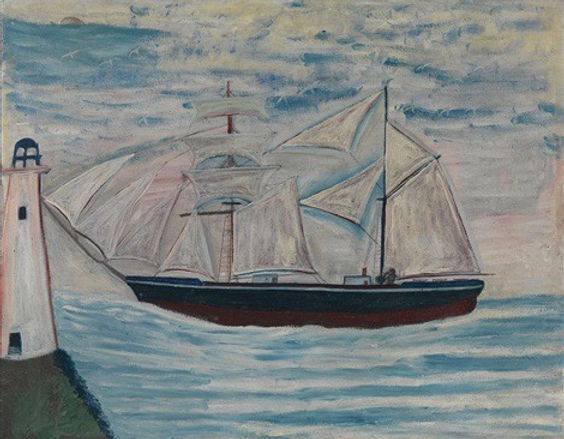

A ship in a bottle, made by Thomas Griffin of Doyle Street, Waterford. A crew member of the SS Coningbeg, Griffin died when the ship was torpedoed in 1917. On display in the Bishop’s Palace.
Wallis was not the only sailor with creative talents – there is a wide range of sailors’ folk art, much of it produced during the nineteenth century when the nature of sailing meant relying on the winds, resulting in long hours of waiting around on deck. Already adept at securing sails in high winds, in their spare time some sailors created elaborate knot art, using their rope-tying skills to make bags, belts, knot boards, or even decorative pictures. More unpleasantly, sailors passing the time on whaling ships sometimes carved elaborate pictures and patterns on the teeth and bones they took from their prey, a practice known as scrimshaw. Others created intricate ships-in-bottles, some of which you can also see in the Bishop’s Palace. However this painstaking work had to be done on dry land, often by retired mariners with more time on their hands, since the confined space below deck and the rolling motion of the ship did not lend themselves to delicate model-work. There was no fear of this happening with embroidery. Easy to store and hard to damage, embroidery was a natural extension of daily life onboard ship. Sailors had to repair their clothes from the wear and tear of life on deck – and even more importantly, they had to repair torn sails as well. This ability with a needle and thread paved the way for a curious type of maritime folk art: the sailor’s woolly.
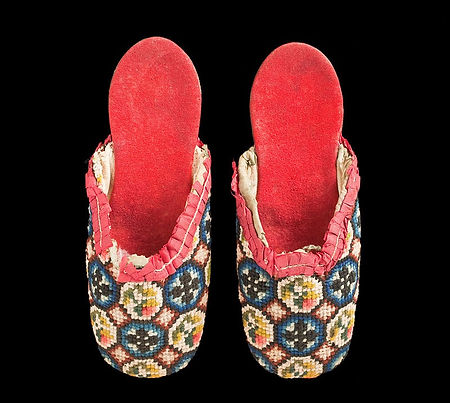
Deeply fashionable at the time: Berlin wool work slippers. Source: https://en.wikipedia.org/wiki/Berlin_wool_work
The embroidered pictures of ships, better known as sailors’ woollies, began to be created in the 1830s and remained popular until the end of the First World War in 1918. The practice began at a time when embroidery was a popular hobby. Colourful, durable and fashionable, Berlin wool work could be used to decorate everything from slippers to fire screens. Cheap instruction sheets (also known as patterns) showed the user exactly how to embroider their own pieces. It’s possible that the woollies were also inspired by the Chinese embroideries being bought by the British in the Chinese Treaty ports, which had opened for trade in 1842. More certainly, woollies do seem to have been done predominately by British sailors (or Irish sailors in the British Navy), since many of them feature a Union Jack.
Unlike the middle-class housewives, following the (fairly kitsch) designs provided by the Berlin wool work patterns, sailors designed the woollies themselves, usually drawing the image in ink first, and then filling it in with their needle and thread. Although all the materials – cloth and thread – could be found onboard, it seems instead that sailors often saved up their money to buy embroidery canvas (rather than use the tougher sailcloth), and colourful silk threads that cheaper dying processes had made more affordable. They also experimented a little, with some adding sequins, glass beads, and bits of bone and metal sometimes into their work. However, they did tend to be economical with materials – they favoured the long stitch, which was fast and made the most of their thread since it involved long stitches on the front and only short ones on the back. Analysis of some of the woollies also reveals that sometimes the yarn had been unpicked from other projects and reused!
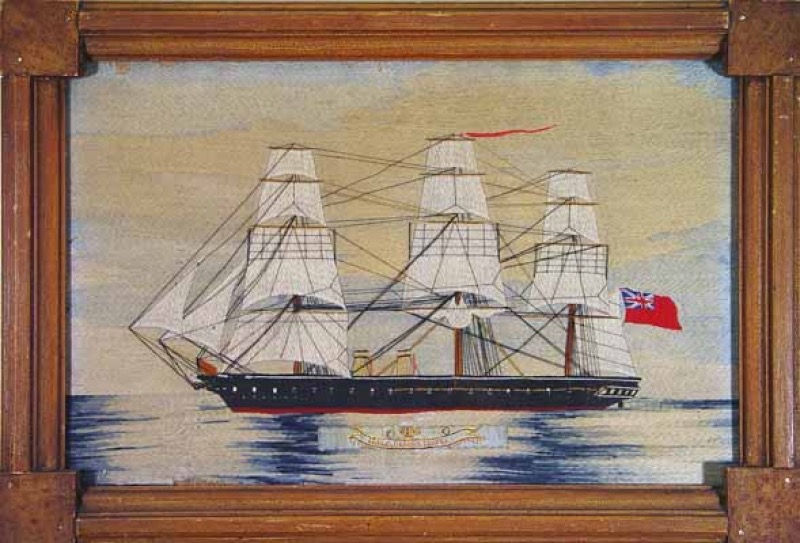
Woolly of the HMS Black Prince 1860-70.
The woollies appear to have been made as mementos of the sailor’s voyage or as a gift for someone back home. Though there is a certain format to them – generally they show the ship from the side – no two are the same. In some, you can see dry land, a lighthouse, or more ships in the distance. Some sailors were able to catch the swell of the sea or the reflection of the setting sun – in others, the image is more stylised and the sea looks more like a chessboard of white and blue. Some of the woollies are framed by curtains, as if the picture is a drama unfolding on a stage, while others (like ours) are in a circle, as if viewed through a porthole or telescope. By the end of World War I, woollies had fallen out of fashion – fewer sailors were needed on the newer ships and had less free time for creative hobbies – but occasionally woollies do depict the newer steam ships too.

The steam and sail ship, HMS Hercules.
Usually unsigned, it is often hard to identify the artists of these woollies, though sometimes the name of the ship is included. Even then, as ships sometimes changed names when they changed ownership, it can be hard to trace their creator. We believe that the woolly in our museum was created by the sailor who owned it, a man called Patrick Kennedy.
Patrick Kennedy (1887–1963) was born in Waterford city, the son of a bootmaker. In the census of 1901, when he was still a teenager, he is recorded as being a grocer’s porter; the following year he joined the Royal Navy, and remained in it until 1923. He served aboard the HMS Tiger, and saw action in the naval battles of Dogger Bank (1915) and Jutland (1916). Patrick’s brothers George and Richard fought in the war as well – George, wounded in Mesopotamia (present day Iraq) died in a British Army Hospital in Selonica, Greece. Richard survived the war, only to die in the Spanish flu pandemic shortly afterwards. Their parents received a commendation from King George V for having so many sons serving in World War I. After leaving the navy, Patrick spent the rest of his career as a caretaker in Waterford’s Chamber of Commerce. He was called up by the Royal Navy at the outbreak of World War II but was unable to enlist because he had two broken ankles – an injury acquired not during the war, but by falling against the roof while attempting to rescue a cat stuck on the roof of the Chamber of Commerce.
HMS Tiger, an armoured battlecruiser, was very different to the sailing ship in this embroidery. Perhaps Patrick created his woolly while on active service, casting his mind back to an earlier age of seafaring, when warships fought warships, and did not have to fear death from the skies or beneath the waves. However, the woolly is not completely at odds with his experience: the Union Jack features prominently in the embroidery while the ship flies the white ensign, the flag of the British Royal Navy – in the late nineteenth and early twentieth century, these symbols of patriotism became increasingly more pronounced in woollies. In the floral border, England, Scotland and Ireland are all represented with roses, thistles and shamrocks respectively. (The Welsh daffodil makes no appearance, though whether this was because the artist deemed Wales unimportant, had no yellow thread, or felt that it would ruin his colour scheme, remains unclear.)
The ships in the sailors’ woollies often lack the technical brilliance of the seascapes created by trained artists. However, like Alfred Wallis’ simple compositions, they capture a sense of what it is to live your life upon the turbulent surface of the sea – the order and the discipline; the great expanse of sea and sky all around; how the ship becomes the centre of the sailor’s world. The woollies might lack perspective or shading, but they are uncompromisingly accurate when it comes to depicting the masts, guns, flags and rigging of their vessels. Whether tossed on stormy seas, or gliding serenely in the middle of the frame, these woollies with their careful stitches radiate the sailor’s sense of pride in his ship. What else is art, if not the chance to look at the world afresh, through someone else’s eyes?

